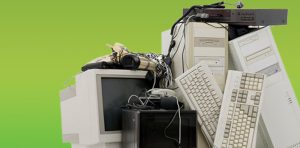Managing Computer Equipment Disposal
One day, your computers, cell phones and other IT equipment will become obsolete. At that time, it will need to be disposed of. The best course of action is to donate or recycle the devices, rather than simply throw them away. This prevents criminals from getting hold of the data that may be stored on your old equipment and keeps valuable materials like metals out of landfills.
Most states have laws that prohibit throwing any electronic devices in the trash, even if they are broken. In addition, many of these devices contain toxic materials like lead and mercury that pose a health risk to people who handle them. This is why it is important to follow the three R’s of computer equipment disposal: Reduce, Reuse and Recycle.
Many of these devices have valuable components that are in high demand for someone who wants to make a new device from it. Computer monitors, for example, often have a picture tube known as a cathode ray tube that is composed of leaded glass. These tubes account for the largest source of lead in municipal waste streams. Lead is also used in printed circuit boards and solder. All of these chemicals are dangerous to handle and could be hazardous if they find their way into the environment.
A reputable ITAD (IT Asset Disposition) company will take the equipment to an approved electronics recycling facility for dismantling and recovery of these precious metals and other materials. They will also dispose of the non-recyclable parts such as glass, plastic and circuit board components. In this way, they will be able to offer your organization a full range of State DEP and U.S. Federal EPA compliant computer recycling services, including on-site bulk data destruction, IT asset inventory tracking and reporting, IT asset grading and refurbishment for redeployment, and fully R2 V3 certified electronics recycling.

Managing Computer Equipment Disposal
Before the hardware is disposed of, it should be wiped clean. This will prevent personal information from falling into the hands of criminals, and it will also protect your business from liability issues should an employee’s hard drive get stolen. It is possible to use software programs that will securely wipe the drives for you and make them unreadable, but it’s better to hire a professional if the data needs to be completely removed from your hard drives.
Ideally, you will have a process for your employees to follow to ensure that all IT assets are properly disposed of when they reach the end of their life. This can be streamlined by using software that helps to track and manage all of your IT assets. This will help you keep track of what needs to be discarded, when it should be discarded and who is responsible for each step in the process.
Make sure your IT team is aware of the importance of implementing proper hardware disposal methods. This will help you avoid security breaches, e-waste violations and other costly penalties that can be associated with non-compliance. When transporting computer equipment for disposal or recycling, handle it with care to prevent damage. Pack the devices securely in boxes or padded containers to avoid breakage during transit.